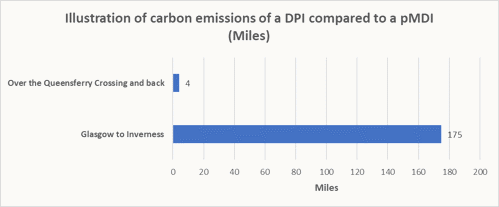Inhaler prescribing
- NHS Scotland has committed to be a net zero greenhouse gas emissions organisation by 2040.8
- It is estimated that NHS Scotland emissions due to inhaler propellant was 81,072 tonnes of carbon dioxide (CO2) equivalent in 2022/23. This is approximately the same as 81,000 people flying from London to New York.
- Approximately 3% of the carbon footprint of NHS Scotland results from the use of metered dose inhalers (pMDI), more than from NHS fleet and waste combined.74,8 Salbutamol alone accounts for two thirds of the total carbon footprint from pMDIs.29
-
Prescribing data for the year 2020/2021 shows that in NHS Scotland 68% inhalers dispensed were pMDI and 32% were dry powder inhalers (DPI) or soft mist inhalers.
-
The UK has a high proportion of pMDI use (70%) compared with the rest of Europe (< 50%) and Scandinavia (10–30%)75. Asthma mortality rates amongst members of the European Union are 0.63 per 100,000 population compared to the UK which are 1.23 per 100,000 population.30
- Health care professionals should be aware of the differences in environmental impact and global warming potential of metered dose inhalers (pMDI), dry powder inhalers (DPI) and soft mist inhalers (SMI).
- A UK based post-hoc analysis has demonstrated that patients can be changed from an MDI to a DPI without loss of asthma control.78
-
Delivery of SABAs via a pMDI and spacer or a DPI leads to a similar improvement in lung function as delivery via nebulizer.26,79 Individuals are generally able to generate PIFR of 30 L/min with any device and most can reach 60 L/min with medium-low resistance devices even during exacerbations.79
The figure belowhighlights the approximate difference in greenhouse gas emissions comparing a Ventolin® Evohaler® with Ventolin® Accuhaler® or salbutamol Easyhaler® and illustrates the equivalent carbon emissions from driving a car emitting 180g CO2/Km. Many people recognise the carbon emissions from driving and therefore this can be a helpful comparison. The calculation is based on an average of 12g of propellant per MDI. There are currently two types of propellants used, HFA-134a and HFA-227ea which have a global warming potential (GWP) of 1300 or 3350 times greater than CO2.The carbon emissions were estimated by multiplying the estimated weight of HFA propellant by its GWP. We have assumed that DPIs have zero emissions (due to absence of propellant).
Illustration of carbon emissions of a DPI compared to a pMDI

Equivalent car exhaust emissions CO2 emissions from a Ventolin Evohaler (containing 100 x 2 puff doses) and a Ventolin Accuhaler (60 x 1 puff doses) or Salbutamol Easyhaler (200 x 1 puff doses). Assumes car achieves 180g CO2/Km.
